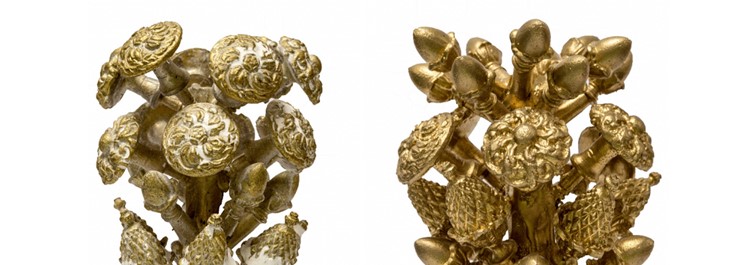
An item manufactured by lost wax casting before and after finishing by wet blasting
Casting is used to manufacture a vast range of different items. From metal components, like engine blocks and turbine blades, to jewellery and medical implants, casting is a very widely used manufacturing process.
The process involves pouring molten material into a mould, allowing it to solidify, and then removing the mould to reveal the finished product. Various materials can be cast, including metals, composites, biocompatible materials, plastics, and even certain types of glass.

Components manufactured by casting, the casting process, and lost wax moulds
Wet blasting, also known as vapor blasting, is a surface finishing process that involves the use of a slurry mixture of water and abrasive media that is blasted at a component’s surface by compressed air. It’s a process that has proved very popular in the jewellery business where the finely controlled nature of the process leaves components with a satin finish prior to polishing. The finishing process can provide several benefits when used for finishing castings, including:
Improved surface finish: Wet blasting can achieve a consistent and uniform surface finish on castings. The combination of water and abrasive media helps to remove surface irregularities, burrs, and other imperfections, resulting in a smoother and more refined surface.
Reduced material removal: Unlike dry blasting methods, wet blasting is a more controlled process. The presence of water in the slurry acts as a lubricant, reducing the wear on the casting material. This allows for precise material removal without causing excessive damage or altering the dimensions of the casting.
Reduced dust and contamination: Wet blasting eliminates the generation of dust that’s associated with dry blasting techniques. The water in the slurry suppresses dust particles, preventing them from becoming airborne. This not only creates a cleaner working environment but also removes the risk of inhalation of harmful substances and any potential of dust associated explosion.
Enhanced surface cleaning: Wet blasting effectively removes various contaminants such as rust, scale, oils, and coatings from castings. The combination of water and abrasive media loosens and dislodges these impurities, leaving the surface clean and ready for subsequent processes like coating, painting, or inspection.
Controlled surface roughness: Wet blasting allows for precise control over the level of surface roughness (Ra). By adjusting the abrasive media size, concentration, and blasting parameters, operators can achieve the desired texture and roughness required for specific applications.
Preservation of component integrity: The gentle nature of wet blasting makes it suitable for delicate castings and intricate shapes. The water cushioning effect minimizes the risk of part distortion or damage, preserving the overall integrity of the casting during the finishing process.
Eco-friendly operation: Wet blasting is considered more environmentally friendly than alternative finishing methods. The addition of water reduces airborne pollutants, and the need for harmful chemicals in the finishing process is removed. Additionally, the wastewater generated can be properly treated before disposal.
Reduced stress concentration: Wet blasting helps alleviate stress concentration points that may exist in cast components. The process gently removes material from the surface, smoothing out irregularities and minimizing the risk of stress cracks or failures due to localised stress concentrations.
Improved fatigue performance: The surface treatment provided by wet blasting can enhance the fatigue performance of cast components. It can peen the surface transforming tensile stresses into compressive stresses to help reduce the risk of component failure in known areas of weakness and in so doing extend the life of the item.
Surface preparation for coating and bonding: Wet blasting can be used as a preparatory step for subsequent post-processing operations such as painting, coating, or bonding. By creating a clean and uniformly textured surface, it enhances the adhesion and quality of subsequent coatings or treatments applied to cast items. The process creates a ‘wet-out’ surface that ensures an even and complete application or adhesives and coatings.
Coating enhancement: Once a cast item has been coated, wet blasting can be used to ensure the coating is consistent and free from imperfections like coating droplets, to leave a uniform surface with an optimum Ra.
Coating performance improvement: The conversion of tensile stresses to compressive stresses by wet blasting, as mentioned above, can be applied to coatings as well to help improve coating durability.
It's worth noting that the specific benefits of wet blasting can vary depending on the type of casting material, the desired finish, and the equipment and techniques used.
All of these benefits make wet blasting the ideal choice for finishing cast items quickly, efficiently, and in an eco-friendly way.